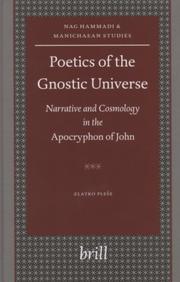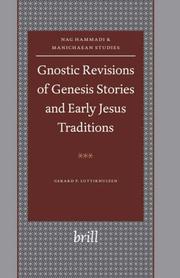| Listing 1 - 9 of 9 |
Sort by
|
Book
ISBN: 0961380535 Year: 1987 Publisher: Baltimore Halgo
Abstract | Keywords | Export | Availability | Bookmark
 Loading...
Loading...Choose an application
- Reference Manager
- EndNote
- RefWorks (Direct export to RefWorks)
Book
ISBN: 9788843098293 8843098292 Year: 2019 Publisher: Roma: Carocci,
Abstract | Keywords | Export | Availability | Bookmark
 Loading...
Loading...Choose an application
- Reference Manager
- EndNote
- RefWorks (Direct export to RefWorks)
Jésus-Christ --- Jesus Christ --- Jesus Christ. --- Interprétations gnostiques. --- Gnostic interpretations. --- Bible --- Apocryphon of John --- Apocryphon of John. --- Criticism, interpretation, etc. --- Jésus-Christ --- Interprétations gnostiques. --- Iohannes ap. ev. --- Apocryphum Iohannis

ISBN: 0674039602 9780674039605 9780674030558 0674030559 0674019032 0674265122 Year: 2009 Publisher: Cambridge, Mass. : Harvard University Press,
Abstract | Keywords | Export | Availability | Bookmark
 Loading...
Loading...Choose an application
- Reference Manager
- EndNote
- RefWorks (Direct export to RefWorks)
Karen L. King offers an illuminating reading of this ancient text, said to be Christ's revelation to his disciple John. In her analysis, the Revelation becomes a comprehensible religious vision--and a window on the religious culture of the Roman Empire. A translation of the complete Secret Revelation of John is included.
Christian literature, Early --- History and criticism. --- Apocryphon of John --- Apocalypse of John (Gnostic) --- Secret book of John --- Secret revelation to John --- Apocryphon Johannis --- Criticism, interpretation, etc. --- Bible --- Critique et exégèse.

ISBN: 9004116745 9789004116740 9786611384333 128138433X 9047404025 9789047404026 9789047404026 9781281384331 Year: 2006 Volume: 52 Publisher: Leiden ; Boston : Brill,
Abstract | Keywords | Export | Availability | Bookmark
 Loading...
Loading...Choose an application
- Reference Manager
- EndNote
- RefWorks (Direct export to RefWorks)
This volume is both an essay in Gnostic poetics and a study in the history of early Christian appropriation of ancient philosophy. The object of study is the cosmological model of the Apocryphon of John , a first-hand and fully narrated version of the Gnostic myth. The author examines his target text against a complex background of religious and philosophical systems, literary theories, and rhetorical techniques of the period, and argues that the world model of the Apocryphon of John is inseparable from the epistemological, theological, and aesthetic debates within contemporary Platonism. Poetics of the Gnostic Universe also discusses the composition and narrative logic of the Apocryphon of John , explores its revisionist attitude towards various literary models (Plato’s Timaeus , Wisdom literature, Genesis), and analyzes its peculiar discursive strategy of conjoining seemingly disconnected symbolic ‘codes’ while describing the derivation of a multi-layered universe from a single transcendent source.
Bible --- Criticism, interpretation, etc. --- Apocryphon of John --- Criticism, interpretation, etc --- 273.1*35 --- 273.1*35 Gnosis: Koptische bronnen: Nag Hammadi; Codex Jung; Evangelium veritatis --- Gnosis: Koptische bronnen: Nag Hammadi; Codex Jung; Evangelium veritatis --- Apocalypse of John (Gnostic) --- Secret book of John --- Secret revelation to John --- Apocryphon Johannis

ISSN: 09292470 ISBN: 9004145109 9047417054 9789004145108 9789047417057 Year: 2006 Volume: 58 Publisher: Leiden ; Boston : Brill,
Abstract | Keywords | Export | Availability | Bookmark
 Loading...
Loading...Choose an application
- Reference Manager
- EndNote
- RefWorks (Direct export to RefWorks)
This book argues that the intellectuals behind early Gnostic revisions of Genesis stories were second-century Christians with an ideological background in Greek-Hellenistic philosophy, who adopted and reinterpreted biblical narrative materials with a view to exposing the inferiority of the creator-God of Genesis and the ignorance of those Christians who continued to worship this God. It also discusses controversies between Gnostic and early orthodox Christians about the person and the mission of Jesus Christ. The first part examines the possible polemical function, the philosophical thought structure, and the narrative scheme of the Genesis rewritings, and continues with studies of individual episodes of the Gnostic myth, from the creation of Adam up to the story of Noah and the Flood. The second part focuses on Gnostic reinterpretations of the teaching and the passion of Jesus. The book includes essays about Gnostic theology, ancient and modern readings of Gnostic texts, and an appendix dealing with the ancient baptist community in which Mani was reared.
273.1*1 --- 273.1*1 Gnosis en Bijbel --- Gnosis en Bijbel --- Relation to the Old Testament. --- Apocryphon of John --- Gnostic literature --- Gnosticism. --- Criticism, interpretation, etc. --- Gnosticism --- Relation to the Old Testament --- Apocalypse of John (Gnostic) --- Secret book of John --- Secret revelation to John --- Apocryphon Johannis --- Criticism, interpretation, etc --- Cults --- Gnostic literature - Relation to the Old Testament.

ISBN: 0674019032 9780674019034 0674030559 0674039602 0674265122 Year: 2006 Publisher: Cambridge, Mass. : Harvard University Press,
Abstract | Keywords | Export | Availability | Bookmark
 Loading...
Loading...Choose an application
- Reference Manager
- EndNote
- RefWorks (Direct export to RefWorks)
Karen L. King offers an illuminating reading of this ancient text, said to be Christ's revelation to his disciple John. In her analysis, the Revelation becomes a comprehensible religious vision--and a window on the religious culture of the Roman Empire. A translation of the complete Secret Revelation of John is included.
Apocryphon of John --- Criticism, interpretation, etc. --- 229*44 --- 229*44 Apocriefe apocalypsen van Johannes, Maria, Paulus, Petrus, Thomas en Stephanus, Zozimus --- Apocriefe apocalypsen van Johannes, Maria, Paulus, Petrus, Thomas en Stephanus, Zozimus --- Apocalypse of John (Gnostic) --- Secret book of John --- Secret revelation to John --- Apocryphon Johannis --- Bible --- Critique et exégèse. --- Christian literature, Early --- History and criticism.
Book
ISBN: 9789042923218 9782763793801 9782758400974 9042923210 Year: 2012 Volume: 35 Publisher: Louvain: Peeters,
Abstract | Keywords | Export | Availability | Bookmark
 Loading...
Loading...Choose an application
- Reference Manager
- EndNote
- RefWorks (Direct export to RefWorks)
Le Livre des secrets de Jean a reçu, à juste titre, le nom de « Bible gnostique ». C'est en effet dans ce traité que nous a été conservée la version la plus complète du mythe auquel se référaient les gnostiques qui faisaient de Seth, troisième fils d'Adam, leur ancêtre. L'auteur y présente une synthèse de l'histoire universelle. On assiste d'abord à la constitution d'un modèle céleste conçu à partir d'une Première Pensée du Grand Esprit invisible, Pensée qui se multiplie jusqu'à produire un modèle parfait constitué de vingt-deux éons, dont le dernier est Sophia, la Sagesse. Mais celle-ci ne pourra résister au désir de construire ce modèle au-delà du nombre parfait et donnera naissance à un 23e éon, celui de l'Archonte. Exclu du modèle mais en gardant le souvenir, l'Archonte en construira une contrefaçon, notre monde, dans lequel il manifestera cette part de connaissance dont il a dépossédé sa Mère. Toute l'histoire de l'humanité, de la création d'Adam au retour annoncé de Seth à la fin des temps, doit alors être interprétée comme une guerre de libération de cette connaissance prisonnière, une guerre dont les hommes, partagés en deux camps, seraient à la fois les victimes et les acteurs. Au moment où l'auteur écrit, rien n'est joué, la domination de l'Archonte est encore universelle, mais grâce à la révélation du « Livre des secrets », l'humanité dispose enfin de cette connaissance qui permettra à ceux qui appartiennent à la semence de Seth de trouver le chemin du retour vers ce monde intelligible auquel ils appartiennent. Cette version du mythe séthien, composée au cours du second siècle de notre ère, nous est parvenue sous deux formes dont la plus longue a retenu l'attention des commentateurs du fait de ses affinités avec l'Évangile de Jean. Celle qui est publiée et commentée dans ce volume, la plus brève et la plus ancienne, n'a été christianisée que superficiellement et conserve encore intacte une version du mythe séthien qui se présente, pour l'essentiel, comme une interprétation du modèle biblique hébreu faite en fonction des règles de l'hermeneutique juive de la période du Second Temple. Un document précieux pour notre connaissance des origines juives du mouvement gnostique.
Bibliotheek van Nag Hammadi --- Bibliothèque de Nag Hammadi --- Codices de Nag Hammadi --- Codices van Nag Hammadi --- Handschriften van Nag Hammadi --- Manuscrits de Nag Hammadi --- Nag Hammadi codices --- Nag Hammadi teksten --- Nag Hammadi texts --- Textes de Nag Hammadi --- Apocryphon of John --- Criticism, interpretation, etc --- 273.1*35 --- Gnosis: Koptische bronnen: Nag Hammadi; Codex Jung; Evangelium veritatis --- 273.1*35 Gnosis: Koptische bronnen: Nag Hammadi; Codex Jung; Evangelium veritatis --- Iohannes ap. ev.
Book
ISBN: 3161529839 9783161529832 Year: 2017 Volume: 441 Publisher: Tübingen: Mohr Siebeck,
Abstract | Keywords | Export | Availability | Bookmark
 Loading...
Loading...Choose an application
- Reference Manager
- EndNote
- RefWorks (Direct export to RefWorks)
David Creech explores at length the Apocryphon of John's ambivalent treatment of the Jewish and Christian scriptures. Although Moses is explicitly corrected at five points in the text, Genesis' account of creation is nonetheless the basis for the Apocryphon's cosmogony and anthropogony. Its uneven treatment of the biblical text is the result of a dispute between the authors of the Apocryphon and other early Catholics. At the earliest stage of the text the Christians who wrote and read the Apocryphon worshiped alongside other early catholic Christians without any sense of contradiction or inconsistency. The key shift in the Apocryphon occurred after Irenaeus of Lyons' assault on “Knowledge Falsely So-Called.” In response to his concerted effort to bring the church under the authority of early catholic bishops, the framers inserted corrections to Moses. The corrections are primarily rhetorical and used to refute early catholic identity markers.
229*42 --- 229*42 Apocriefe handelingen der apostelen van Andreas, Barnabas, Philippus, Jacobus, Johannes, Matthaeus, Paulus, Petrus, Pilatus, Thomas, Paulus en Thecla, Petrus en Paulus --- Apocriefe handelingen der apostelen van Andreas, Barnabas, Philippus, Jacobus, Johannes, Matthaeus, Paulus, Petrus, Pilatus, Thomas, Paulus en Thecla, Petrus en Paulus --- Apocryphon of John --- Apocalypse of John (Gnostic) --- Secret book of John --- Secret revelation to John --- Apocryphon Johannis --- Criticism, interpretation, etc.
Book
ISBN: 3727806060 Year: 1989 Publisher: Freiburg Universitätsverlag
Abstract | Keywords | Export | Availability | Bookmark
 Loading...
Loading...Choose an application
- Reference Manager
- EndNote
- RefWorks (Direct export to RefWorks)
Gnosticism --- Stoics --- 273.1*35 --- Ethics --- Philosophy, Ancient --- Cults --- 273.1*35 Gnosis: Koptische bronnen: Nag Hammadi; Codex Jung; Evangelium veritatis --- Gnosis: Koptische bronnen: Nag Hammadi; Codex Jung; Evangelium veritatis --- Apocryphon of John --- Nag Hammadi codices. --- Nag Hammadi library --- Chenoboskion manuscripts --- Nag Hammadi manuscripts --- Khenoboskion manuscripts --- Najʻ Ḥammādī texts --- Nag Hammadi texts --- Apocalypse of John (Gnostic) --- Secret book of John --- Secret revelation to John --- Apocryphon Johannis --- Criticism, interpretation, etc. --- Bible
| Listing 1 - 9 of 9 |
Sort by
|

 Search
Search Feedback
Feedback About UniCat
About UniCat  Help
Help News
News